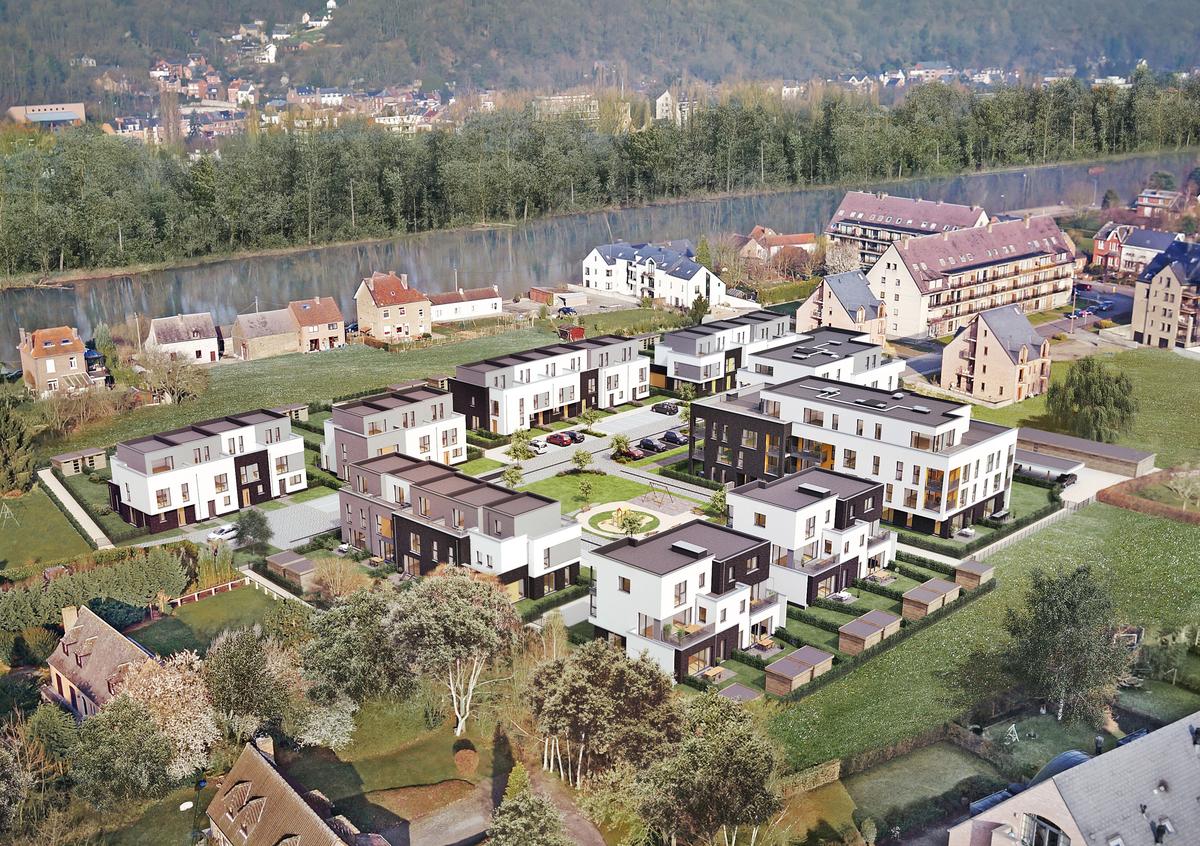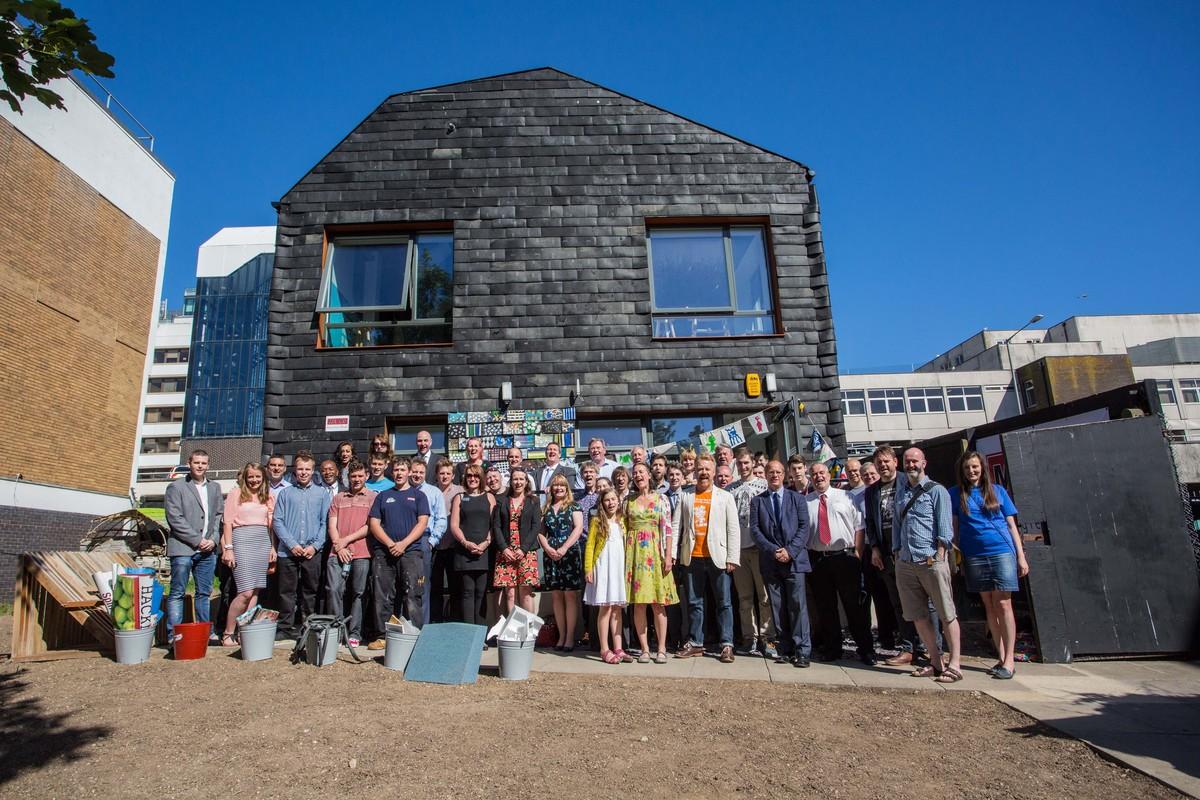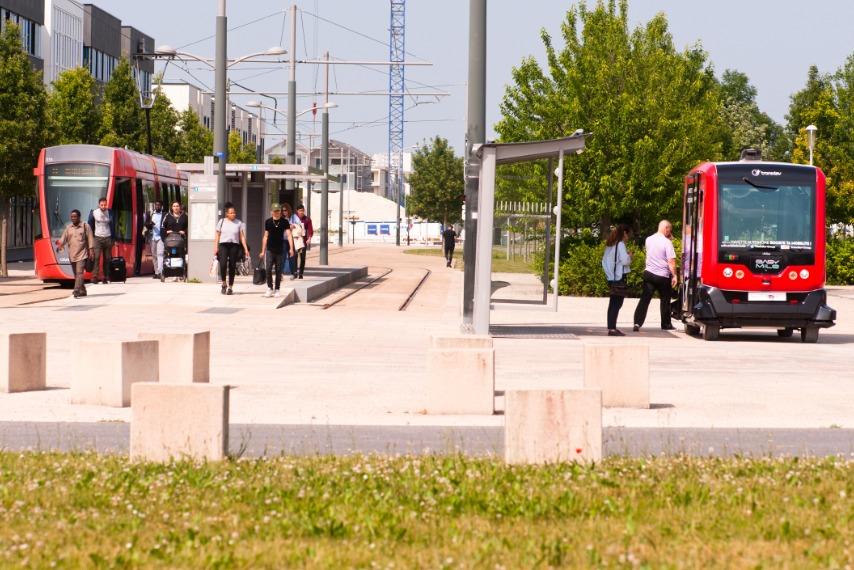What trends in the 2018 Green Solutions Awards?
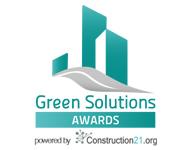
The Green Solutions Awards are an international contest organized by Construction21 to highlight and reward inspiring and innovative construction projects which contribute to the fight against climate change: buildings, districts and infrastructures. The 6th edition, launched in March 2018, counts 103 buildings coming from 11 countries: Austria, Belgium, China, France, Greece, Italy, Luxembourg, Morocco, Romania, Spain and the United Kingdom.
These sustainable buildings can demonstrate some of the trends and statuses of the green building sector in these countries, following the 7 Global ABC themes:
- Human factors - Status and trends on occupant behaviour and human-oriented solutions;
- Resilient buildings - Status and trends on adaptation and resilience;
- Architectural solutions - Status and trends on design and passive (natural, low-tech) solutions;
- Better buildings through better materials - Status and trends of materials, including lifecycle energy and embodied energy;
- Technology solutions - Status and trends on lighting, appliances and equipment (active and high-tech) solutions;
- Urban solutions - Status and trends on urban construction and urban systems;
- Clean energy transition - Status and trends on renewable energy and decarbonising energy used in buildings.
Human factors
The Beehive, participative housing in Bègles, France, national French winner in the Low Carbon category, also obtain a mention from the French student jury.
The candidates of the 2018 edition confirm a trend noticed in the previous year: energy efficiency is less and less achieved at the expanse of users/inhabitants. Health, comfort, well-being are becoming key issues for the owners, the designers and the managers of buildings. While the notion of “pleasure to live in a building” is still emerging in the most advanced buildings in comfort, it is important to note the growing care taken to address thermal comfort, in winter and in summer, visual comfort with more sources of daylight or the layout of interiors.
Among the solutions to increase the quality of health in sustainable buildings, while improved ventilation is still on the rise in tertiary buildings, especially education buildings, ventilation is still insufficient in housings, mostly because of the complexity of uses in this particular type of buildings. The greater care put in the envelope has a serious impact on ventilation and air renewal. However the indoor air quality is better addressed, notably through the use of healthier and natural materials, they emit less VOC.
Remains the issue of managing these buildings to keep them healthy and comfortable to use. In France, comfort of use is emerging as new lead to work on, and already solutions are appearing: using dedicated smartphone applications for the users to pilot their spaces, BMS for building managers to control indoor environment both in energy and comfort, but also new emerging professions such as Assistant to the Contracting Authority for Uses.
A new way to look at the human factor can be also noted: participation. In Spain, inhabitants are more consulted and proactive in urban renewal, while in France, we see participative housing put in place. By giving their personal input in the project, future users are more likely to find a building more fit to their needs and habits.
At a city scale, the Coeur de Ville Ecodistrict - La Possession is an example to follow. Anxious to share with its inhabitants a new way of living the city, the municipality imagined a consultation process from the beginning and throughout the life of the project; especially through visits to the site and the implementation of the project "2025, I imagine my city of tomorrow" for schools.
In the Ecodistrict Les Mureaux, a popular low-income area, the revival produced by the transformation of the city has created a real civic dynamic organized around the association "Vivre les Mureaux". The goal is to achieve full employment in 7 years by living together and revitalizing the link through meetings and culinary trips.
Quelques exemples de bâtiments et de quartiers qui mettent l’humain au centre parmi les candidats des Green Solutions Awards 2018 :
Some examples of buildings taking human factors into account from the Green Solutions Awards 2018:
France
- Delta Green (BMS, user’s guide, monitoring, informative screen, great care on natural lighting) - https://www.construction21.org/case-studies/fr/delta-green.html
- Luminem (BMS, building dedicated app for users) - https://www.construction21.org/case-studies/fr/luminem.html
- House of Ile de France (Acoustics, natural ventilation, BMS)- https://www.construction21.org/case-studies/fr/house-of-ile-de-france.html
- The Beehive (participative housing) – https://www.construction21.org/case-studies/fr/the-beehive.html
- Ecodistrict Cœur de Ville – La Posession
- Ecodistrict Molière - Les Mureaux
Spain
- Aulario IndUVA (Well approach, acoustics, BMS) - https://www.construction21.org/case-studies/es/aulario-induva.html
Resilience
Eco-district Jambes in Belgium
With climate change and more frequent climate change related weather events, we will see more resilient buildings in the future. However resilience is still an budding trend. In 2018, we observed only three case studies taking resilience into account:
- In Luxembourg, one building has been designed with its whole life cycle thought through, including its deconstruction.
- In the United Kingdom, architects built an amphibious house, capable of floating on the Thames when the river leaves its bed.
- In France, a supermarket used white paint on its roof to withstand summer heat and reduce the urban heat island phenomenon
- In Japan, a micro-grid facilitates mutual exchanges between the various public buildings of the city (hospitals in particular); and a large battery storage ensures the production of electricity for 3 days in case of disaster
Public spaces also want to be more resilient, especially in the management of rainwater.
- In Paris Saclay, the Joliot-Curie silver garden is a link in its own right in the ZAC hydraulic system
- In the Bords de Seine Eco-district, rainwater management is carried out by means of storage and infiltration systems after purification thanks to the general slope of the land.
- In Belgium, the Jambes Eco District has been waterproofed to a minimum to ensure direct infiltration of rainwater. For the rest, water is timed on the roof and used for the maintenance of green spaces
Some examples of buildings, infrastructures and resilient neighborhoods that are candidates for the Green Solutions Awards 2018:
France
- E.Leclerc Center in Quimper
- Jardin argenté of Joliot Curie district - Plateau de Saclay
- Ecodistrict Bords de Seine
United Kingdom
Belgium
Japan
Architectural solutions
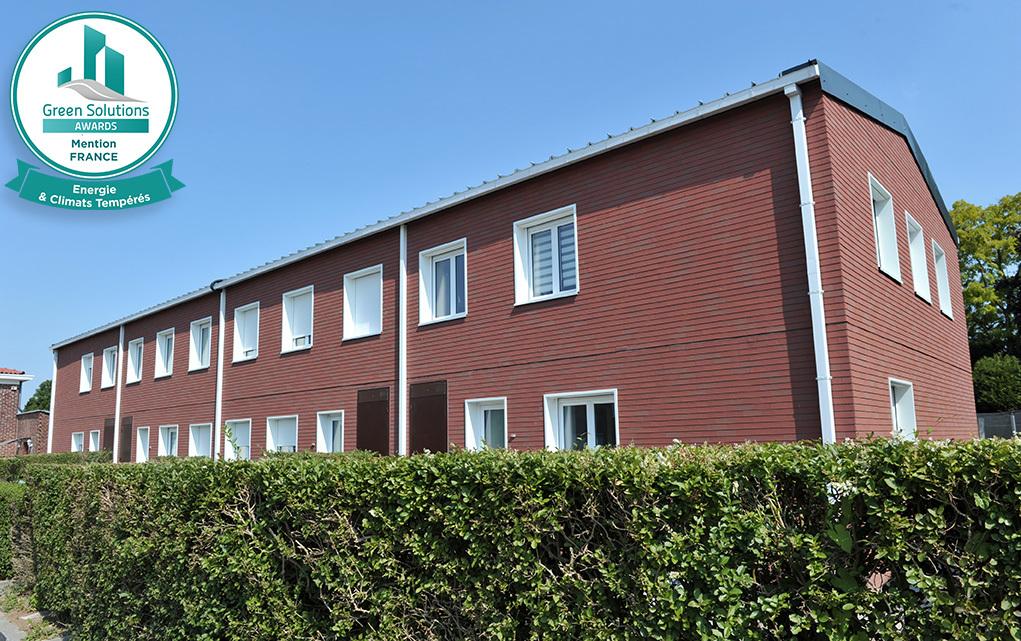 |
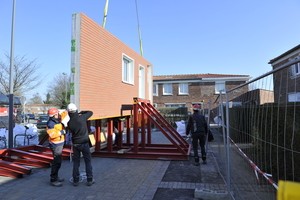 |
Energiesprong rehabilitation in Hem (France), national French jury mention for the Energy & Temperate Climates
This year’s edition confirms observations made during the five previous Green Solutions Awards, in terms of architecture, the envelope is the crucial point every sustainable building works on. And over the years, we can see massive progress on that topic. Designers and builders take great care of the envelope, either in new construction and in refurbishment. The influence of passive buildings principle is very perceptible in the projects presented in 2018, under temperate climates and hot climates.
Bioclimatic principles are also adopted by architects and engineers to optimize natural lighting, passive gains and natural ventilation, as it can be observed under tropical climates like French Guyana or Reunion Island.
Ingenuous architectural solutions are to be noted in the 2018 edition:
- Use of plants inside, outside and on top of buildings to create a cooler climate during the summer
- Prefabricated walls and construction elements often including the insulation, to speed up the construction or the renovation process and optimize the envelope efficiency
It is important to note that architectural solutions less and less often focus on energy efficiency only. Building designers adopt a more global vision to integrate other factors: health, comfort, mobility, renewable energies, urban integration and collaboration…
Some examples of buildings using architectural solutions from the Green Solutions Awards 2018:
Greece
- Passivistas: the House project (full passive refurbishment)
France
- Avenidor
- Hem Rehabilitation Energiesprong ( prefabricated solution for external insulation)
- Thémis (vegetation of facades and roofs)
Spain
- Carrer nou (passive renovation of a condominium)
Belgium
Better buildings through better materials
The Waste House in Brighton (United Kingdom)
While concrete remains one of the easiest and cheapest solutions in today’s construction, this year’s Green Solutions Awards showed a growing use of bio-based materials:
- Wood is the most commonly used bio-based material, for timber frames, but also for envelopes, sometimes associated with other bio-based and geo-based materials
- Straw is more accepted as insulation material, we find it even in PassivHaus certified buildings
- Rammed earth, while still rare, is found in a couple of projects
- Terracotta, for roofings and façades
- Cellulose and hemp waddings insulate more and more buildings
- Also in Italy, an interesting use of sheep wool
This demonstrates a growing concern about the carbon footprint of buildings and for the use of natural healthy materials.
Bio-based materials are not the only interesting materials to lower the carbon footprint of buildings. Recycled materials are emerging. One extreme example came from the UK: the Waste House, built out of 90% waste material and yet achieving high energy efficiency. The London Aquatic Center is another example of a building using recycled materials: recycled and recyclable sails, secondary aggregates from the terrain to make cement and concrete…
But professionals need to make sure their buildings’ carbon footprint has been reduced. With the growing concern in CO2 and the increase of new materials, Life Cycle Analysis becomes more and more relevant, yet, these analyses are not massively adopted as of today. Only pioneers and demanding owners spend the time and energy to make sure their building is truly environmentally friendly. And even so, calculation methods and designated perimeters do vary a lot, making comparisons very difficult. There is room to improve on that aspect. In France, the E+C- experimental certification is an interesting step in that direction, although it only concerns new buildings and not refurbishments.
Some examples of buildings using low carbon solutions from the Green Solutions Awards 2018:
United Kingdom
- The Waste House (90% waste as construction material)
- London Aquatic Center (secondary aggregates cement and concrete, recyclable and recycled sails) -
France
- The Beehive (rammer earth, straw and wood)
- Prefabricated wood-concrete hemp panel building – Triballat
- LowCal (E+C- experimental certification, low tech and biobased materials)
- CFA BTP in Blois
Romania
- CLT multicomfort office building (wood frame and cellulose wadding)
Technology solutions
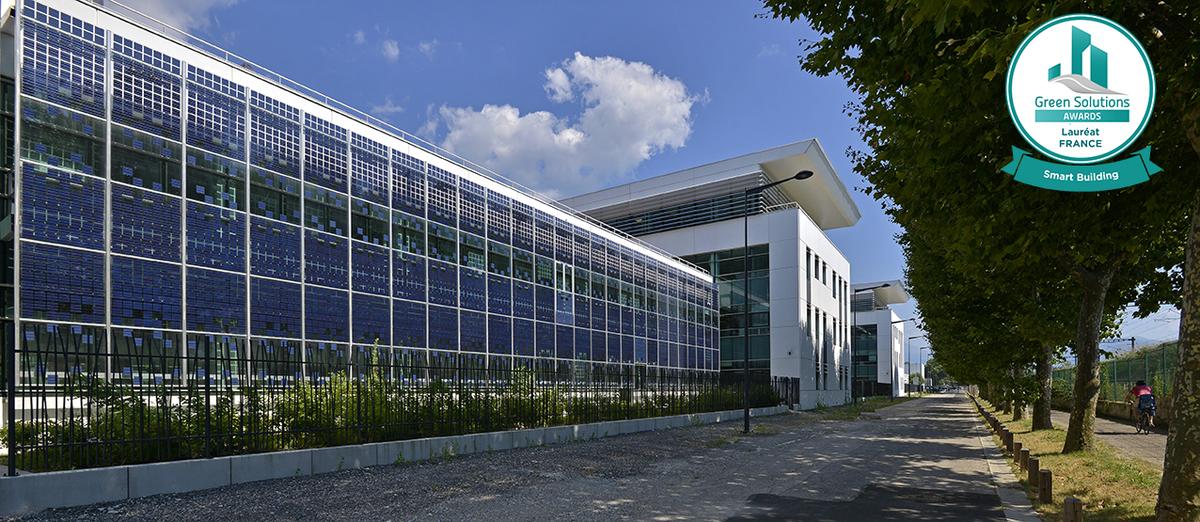
Schneider Electric's Technopole in Grenoble (France), national French winner in the Smart Building category
We observe that building management is a focus in the sector as of late, and not only in tertiary buildings. Along with BMS, we see smart lighting solutions and home automation emerge. In terms of equipment, designers, builders and owners favor high energy efficiency. Heat recovery is getting more and more adopted, mostly in ventilation systems, but also in water management.
Interestingly, buildings are starting to be considered for their digital value: the data they can provide, but also their role as a hub of services. The R2S certification in France is a testimony of that rising awareness.
Some examples of buildings using technology from the Green Solutions Awards 2018:
France
- Maison de l'Ile de France (BMS, automation)
- Technopole
Urban solutions
Autonomous transport service in Reims, France
While the connection of buildings to urban heating/cooling networks is becoming a common practice when it’s possible, the connection of the building to its urban environment is strengthening over the years, especially when it comes to mobility. Designers and urban planners integrate the flow of users and inhabitants in their project, the connection to transportation networks, parking opportunities, and soft mobilities (bike parks, electric car stations…).
While the building now depends more on its urban environment, the reverse is also true, as the district can rely on one or more buildings for some services. We see more and more smartgrid ready positive energy buildings emerge to lighten the load on the electric network, redistributing its renewable energy production to surrounding buildings. Some buildings are also a biodiversity haven for the district or a source of cooling with green roofs.
Some examples of buildings using urban solutions from the Green Solutions Awards 2018:
France
- Paris Court (urban heating network, mobility integration)
- SOGECAMPUS (bike and electric cars parking slots)
- Power Road
- Autonomous transport service in Reims
Austria
- GreenHouse Student Dorm (urban heating network, bike and electric cars parking slots)
Clean Energy Transition
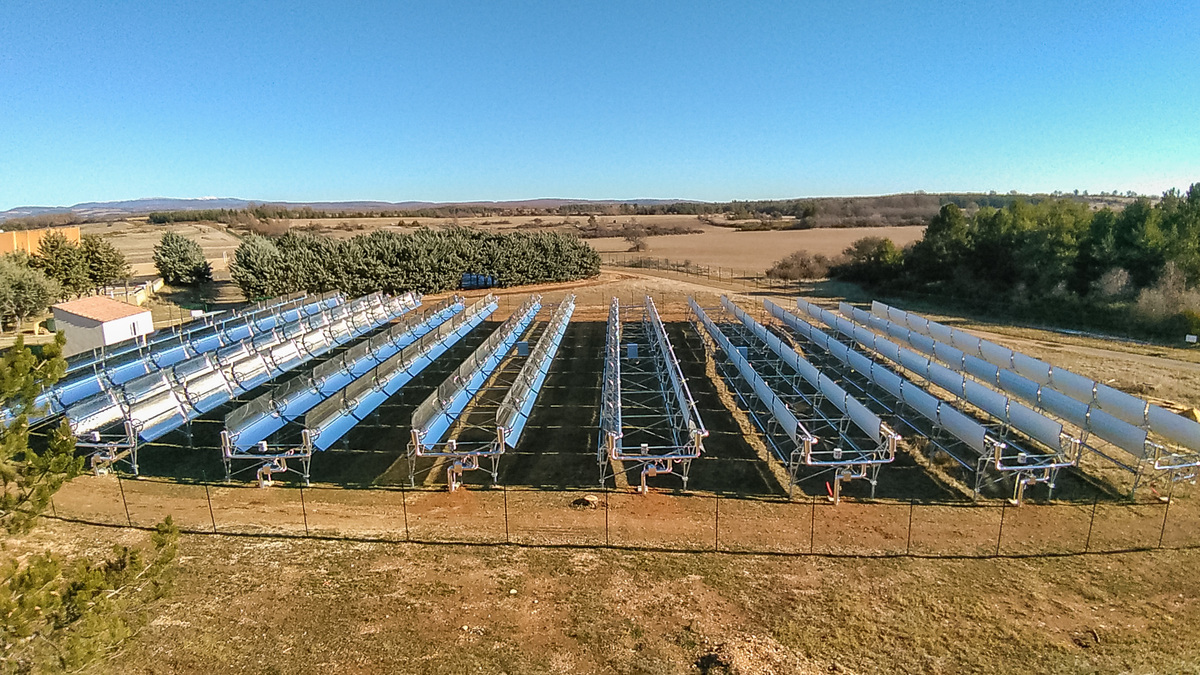
Solar powerplant Helioclim in à Saint-Christol d'Albion (France)
The first observation on this issue: the greatly increased number of buildings using one source of renewable energy or more, combining several systems to improve their energy efficiency, but also to reduce their environmental impact. Unsurprisingly, the most prized renewable energy is solar, with photovoltaic panels for electricity and solar thermal energy for hot water. Coming second: geothermal energy with heat pumps and Canadian wells. Wood boilers are still popular but biomass boilers are on the rise, for larger buildings especially, like the London Aquatic Center.
This trend is also true at the neighborhood level. In the outskirts of Nantes, the district of La Fleuriaye aims for a neutral energy balance with a contribution to renewable energy equivalent to all-purpose consumption, thanks to a solar system installed on the roof of housing and the development of self-consumption.
Second: geothermal energy with heat pumps and Canadian wells. Massileo, the smart renewable energy network is a good illustration. This thalassothermy network supplies the Smartseille eco-district with heating, air-conditioning and hot water from 75% renewable energies. Wood-fired boilers are still popular, but biomass boilers are becoming increasingly popular, especially in large buildings such as the London Aquatic Center.
We observe also a rising interest for harvesting fatal energies. One example this year would be the energy recovery on lift brakes.
Emerging trend of this edition and widely rewarded at the Green Solutions Awards, the hydrogen storage. This technique makes it possible to store the production of renewable energies over a long period.
In Vannes, a hydrogen station has been designed to recharge cars running on this energy. Interconnectable with Smart Grid buildings, the station can store the surplus energy of a building and redistribute them when needed.
Some examples of buildings using renewable energies from the Green Solutions Awards 2018:
Austria
- GreenHouse Student Dorm (Solar photovoltaic, power storage)
- Mineroom Student Residence (Lifts with energy recovery on brakes, solar photovoltaic)
Spain
- Residential Scenia (Solar thermal)
United Kingdom
- London Aquatic Center (Biomass boiler)
France
- Convergence (Geothermal heatpump)
- House of Ile de France (giant solar thermal water tanks)
- Departmental Direction of territories and the sea of Morbihan-Vannes (wood boiler)
- District of La Fleuriaye in Carquefou
- Helioclim solar powerplant
- Hydrogen charging station for Smart Grid buildings
- Massiléo





